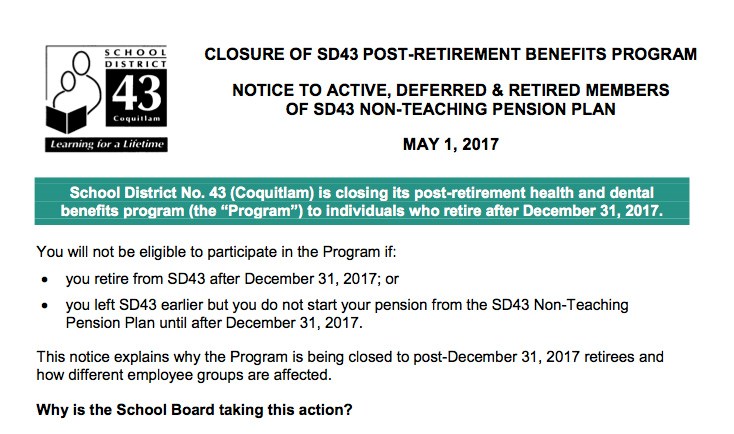A $50-million shortfall in pension funds for managers and CUPE support workers is the impetus behind the looming closure of a health and dental plan for those same workers when they retire, The Tri-City News has learned.
Hundreds of managers and CUPE support workers are expected to lose post-retirement health and dental benefits if they retire after Dec. 31, prompting an exodus of near-retirement workers, CUPE Local 561 president Dave Ginter predicted.
“There’s a lot of sad stories out there,” said Ginter, who said closing the health and dental plan for retirees was a punitive measure that could have been avoided if the district set money aside for the solvency issue or required workers to contribute to the extended health plan.
"There’s a mass exit out the door now for people worrying about this." — Dave Ginter, CUPE 561 president
Instead, the plan will be closed and funds used instead to pay $3.5 million a year to eliminate the pension solvency gap, a move School District 43 had no choice but to make, according to its secretary treasurer, Chris Nicolls.
“The school district had projected a shortfall of approximately $50 million over a year ago and made the determination that the required payment would not occur by reducing educational services or existing levels of teachers,” Nicolls said in an email to The Tri-City News.
A Dec. 31, 2016 actuarial evaluation confirmed the gap, resulting in efforts to move approximately 2,000 beneficiaries — including 700 retirees, 200 members who have taken a deferral and 1,100 active employees — to the municipal pension plan to resolve the solvency issues.
NEGOTIATIONS FELL THROUGH
But when negotiations fell through on the pension transfer, School District 43 moved to close the Post Retirement Retirement Benefits Program and use the money saved to pay for the solvency deficiency.
According to Nicolls, the union was aware of the board’s intention to close the retiree health and welfare plan as early as June 2016 and members were further updated in May of this year after the board publicly announced its intent at a budget meeting.
Closing the plan solves a number of issues for SD43, enabling it to put about $3.2 million towards reducing the gap this year and eliminating a $23-million liability for employee future benefits such as sick leave, vacation and pension for staff still working for the district through the release of approximately $27 million in reserve from the post-benefit plan.
The solvency payments were supposed to be $5 million a year for 10 years but the district got it down to $3.5 million with a letter of credit, which was recently renewed.
LITIGATION A POSSIBILITY
Current CUPE and management retirees won’t lose any of their health and dental benefits, however, and resolving the solvency issue makes the defined benefit pension plan more certain for current and future beneficiaries.
The school district said retired teachers and employees in other districts pay for their own extended health benefits.
Still, Ginter says the elimination of benefits for post-Dec. 31 retirees is a disappointment and was a stick held over the heads of negotiators during efforts to move the non-teaching pension over to the municipal pension plan.
The municipal plan was less generous than the current plan, which is why negotiations fell through, Ginter said, and the union plans to fight back with a public awareness campaign and, possibly, litigation.
“There’s a mass exit out the door now for people worrying about this. Why they closed the plan is punitive as far as I’m concerned.”



